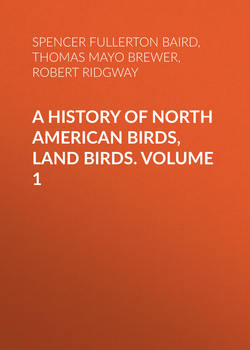A History of North American Birds, Land Birds. Volume 1

Реклама. ООО «ЛитРес», ИНН: 7719571260.
Оглавление
Robert Ridgway. A History of North American Birds, Land Birds. Volume 1
PREFACE
INTRODUCTION
NORTH AMERICAN BIRDS
Family TURDIDÆ.—The Thrushes
Subfamily TURDINÆ
Subfamily MIMINÆ
Family CINCLIDÆ.—The Dippers
Family SAXICOLIDÆ.—The Saxicolas
Family SYLVIIDÆ.—The Sylvias
Subfamily SYLVIINÆ
Subfamily REGULINÆ
Subfamily POLIOPTILINÆ
Family CHAMÆADÆ.—The Ground-Tits
Family PARIDÆ.—The Titmice
Subfamily PARINÆ
Subfamily SITTINÆ
Family CERTHIADÆ.—The Creepers
Family TROGLODYTIDÆ.—The Wrens
Family MOTACILLIDÆ.—The Wagtails
Subfamily MOTACILLINÆ
Subfamily ANTHINÆ
Family SYLVICOLIDÆ.—The Warblers
Subfamily SYLVICOLINÆ
Subfamily GEOTHLYPINÆ
Subfamily ICTERIANÆ
Subfamily SETOPHAGINÆ
Family HIRUNDINIDÆ.—The Swallows
Family VIREONIDÆ.—The Vireos
Family AMPELIDÆ.—The Chatterers
Subfamily AMPELINÆ
Subfamily PTILOGONATINÆ
Family LANIIDÆ.—The Shrikes
Family CÆREBIDÆ.—The Creepers
Family TANAGRIDÆ.—The Tanagers
Family FRINGILLIDÆ.—The Finches
Subfamily COCCOTHRAUSTINÆ.—The true Finches
Subfamily PYRGITINÆ
Subfamily SPIZELLINÆ.—The Sparrows
Отрывок из книги
The class of Birds (Aves), as represented in the present age of the world, is composed of very many species, closely related among themselves and distinguished by numerous characters common to all. For the purposes of the present work it is hardly necessary to attempt the definition of what constitutes a bird, the veriest tyro being able to decide as to the fact in regard to any North American animal. Nevertheless, for the sake of greater completeness, we may say that, compared with other classes,1 Birds are abranchiate vertebrates, with a brain filling the cranial cavity, the cerebral portion of which is moderately well developed, the corpora striata connected by a small anterior commissure (no corpus callosum developed), prosencephalic hemispheres large, the optic lobes lateral, the cerebellum transversely multifissured; the lungs and heart not separated by a diaphragm from the abdominal viscera; aortic arch single (the right only being developed); blood, with nucleated red corpuscles, undergoing a complete circulation, being received and transmitted by the right half of the quadrilocular heart to the lungs for aeration (and thus warmed), and afterwards returned by the other half through the system (there being no communication between the arterial and venous portions); skull with a single median convex condyle, chiefly on the basi-occipital (with the sutures for the most part early obliterated); the lower jaw with its rami ossifying from several points, connected with the skull by the intervention of a quadrate bone (homologous with the malleus); pelvis with ilia prolonged in front of the acetabulum, ischia and pubes nearly parallel with each other, and the ischia usually separated: anterior and posterior members much differentiated; the former modified for flight, with the humerus nearly parallel with the axis of the body and concealed in the muscles, the radius and ulna distinct, with two persistent carpal bones, and two to four digits; the legs with the bones peculiarly combined, (1) the proximal tarsal bones coalescing with the adjoining tibia, and (2) the distal tarsal coalescing with three (second, third, and fourth) metatarsals (the first metatarsal being free), and forming the so-called tarsometatarsus; dermal appendages developed as feathers: oviparous, the eggs being fertilized within the body, excluded with an oval, calcareous shell, and hatched at a temperature of about 104° F. (generally by the incubation upon them of the mother).2
Such are some of the features common to all the existing species of birds.3 Many others might be enumerated, but only those are given which contrast with the characteristics of the mammals on the one hand and those of the reptiles on the other. The inferior vertebrates are distinguished by so many salient characters and are so widely separated from the higher that they need not be compared with the present class.
.....
The eggs are of a very light blue, paler than those of the other species. They measure .89 of an inch in length by .66 in breadth.
Mr. Ridgway states that he found the Rocky Mountain Bluebird nesting in Virginia City in June. Its nests were built about the old buildings, and occasionally in the unused excavations about the mines. At Austin he also found it common in July, in similar localities. On the East Humboldt Mountains it was very numerous, especially on the more elevated portions, where it nested among the rocks and, though more rarely, in the deserted excavations of woodpeckers in the stunted piñon and cedar trees. He describes it as generally very shy and difficult to obtain, seldom permitting a very near approach. In its habits it is much less arboreal than either S. mexicana or S. sialis, always preferring the open mountain portions in the higher ranges of the Great Basin.
.....